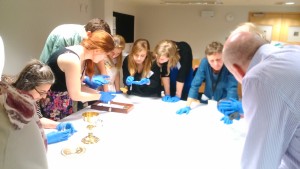This post has kindly been written for us by Róisín Watson, a Scouloudi Fellow at the IHR.
Theological assumptions about the material nature of the divine were central to the debates of the Reformation. The accessories of late medieval Catholic piety, in the form of multiple altarpieces, relics and reliquaries, and tabernacles, to name but a few, fed reformers’ attacks on Catholic worship and its associated beliefs. They argued that the sacred could not be accessed through these material trappings. The materiality of the divine also divided Protestants. Zwingli and Luther disagreed on whether a spiritual reality could be represented physically. For Luther, there was no clear separation between the material and the spiritual. God had revealed himself through the flesh of Christ. For Zwingli, the spirit and the material were irreconcilable – ‘what you give the senses’, he wrote, ‘you take away from the spirit’.
While such debates of the sixteenth and seventeenth centuries framed the experiences of a theological elite, the everyday experience of the Reformation was far removed from these discussions. However, the materiality of religion is no less important for understanding how individuals interacted with the divine and defined their confessional identities. How were confessional cultures differentiated by the relationships they fostered with their material world? How did objects communicate the new theology? How can non-verbal expressions of confessional identities challenge the historical paradigms we currently use to understand this period?
As Scouloudi fellow, in early June I ran a one-day workshop at the V&A, funded by the IHR, RHS and GHS. It was designed to tackle these questions. The workshop brought together museum curators, historians, art historians, and archaeologists for an inter-disciplinary discussion on current research. It also provided the opportunity to integrate the V&A’s collections into our discussion. We were very grateful that curator Kirstin Kennedy was able to bring a smorgasbord of objects for participants to inspect up-close.
Many of the day’s papers revealed the ambiguity of objects, which stemmed from their malleability. The functions and significance of religious objects were defined by their owners or by the spaces that they inhabited. This was particularly true in the case of Allison Stielau’s study of the afterlife of the shrine for the bones of Saint Liborious in Paderborn. When the Catholic city was captured in 1622 by Protestant Christian the Younger, Duke of Braunschweig and Lüneburg, the shrine was melted down and turned into coins known as ‘Pfaffenfeindtaler’. For Protestants, the coins represented their iconoclastic triumph, as well as proof of the impotence of Catholic relics. However, Catholics used these coins too. They believed that touching them was analogous to touching the saintly relics the metal had previously protected. Stielau argued that despite the re-casting of the silver, the material retained the memory of its previous form.
The malleability of the meaning of objects has meant that they defy the neat labels placed upon them by scholars. In her paper, Suzanna Ivanič challenged the distinction historians have drawn between magic/superstition and religion in the early modern world. The inventories of citizens in Prague contain objects that resist this simple binary opposition. Catholic rosaries might contain non-traditional materials such as coconut shells, snake’s tongues and wolves’ teeth. Ivanič argued that these items demonstrate the co-existence of magical and religious beliefs, which in the mind of their owners were not discrete categories.
Lutherans, too, actively engaged with their material surroundings. Distinguishing what was a ‘Lutheran’ object as opposed to a ‘Catholic’ one was not straightforward, as Mirko Gutjahr demonstrated. Gutjahr is currently curating an exhibition on what he refers to as ‘Luther’s rubbish’, that is the archaeological finds from Luther’s house in Wittenberg from the 1530s and 1540s. Gutjahr argued that there was, in fact, very little to distinguish the site as Lutheran. Catholic objects and motifs remained, indicating that a ‘Lutheran material culture’ did not exist at this early stage. Lutherans did occupy a middle ground, neither embracing the spiritual power of the object nor rejecting the utility of material religion indiscriminately. In her paper, Margit Thøfner demonstrated how Lutherans in Denmark consciously edited their catholic past by re-framing medieval altarpieces to suit the new theological standards.
Another theme that many of the speakers touched on was the agency of objects and how this could make them dangerous and subversive. This was most clear in Lloyd de Beer’s paper on the destruction of English alabasters in the Reformation, where these objects had been consciously disfigured. Irene Galandra Cooper also addressed the subversive qualities of religious materiality. In 1582 Francisco de Cordoba was brought to trial for wearing a pouch containing a variety of suspicious items, such as flesh that looked like a beating heart. Francisco insisted he was simply carrying an Agnus Dei, a wax disc blessed by the pope during the first Sunday after Easter. The object was traditionally hung within homes above the bed, but this case reveals the concerns the church had about their sanctioned sacramentals being used in ways that deviated from their stipulations. Edmund Wareham demonstrated how stone tablets decorated with text in the convent of Villingen allowed the nuns there not to be subversive, but to transcend the restrictions of enclosure. They used these tablets to aid their mental pilgrimages to the Holy Land. The women placed them around the convent to signal different locations on their pilgrimage, which established a sacred topography within the enclosed convent.
The material culture of early modern religion had multiple meanings, but also multiple uses. It defined relationships between and within confessions, between local and official religions, and between different spaces. The workshop demonstrated how difficult it is to speak of a single Lutheran or Catholic identity and to characterise its relationship with the material world. Such relationships were negotiated and in constant dialogue with local customs, the availability of materials, contemporary understandings of the nature of materials, as well as the character of religious reform.



